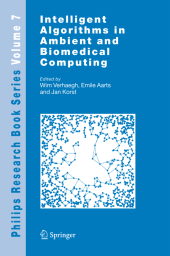 Neuerscheinungen 2014Stand: 2020-02-01 |
Schnellsuche
ISBN/Stichwort/Autor
|
Herderstraße 10
10625 Berlin
Tel.: 030 315 714 16
Fax 030 315 714 14
info@buchspektrum.de |

Emile Aarts, Jan Korst, Wim Verhaegh
(Beteiligte)
Intelligent Algorithms in Ambient and Biomedical Computing
Herausgegeben von Verhaegh, Wim; Aarts, Emile; Korst, Jan
2006. 2014. xxi, 321 S. 235 mm
Verlag/Jahr: SPRINGER NETHERLANDS; SPRINGER 2014
ISBN: 9400787286 (9400787286)
Neue ISBN: 978-9400787285 (9789400787285)
Preis und Lieferzeit: Bitte klicken
This book is the outcome of a series of discussions at the Philips Symposium on Intelligent Algorithms, held in Eindhoven in December 2004. It offers exciting and practical examples of the use of intelligent algorithms in ambient and biomedical computing. It contains topics such as bioscience computing, database design, machine consciousness, scheduling, video summarization, audio classification, semantic reasoning, machine learning, tracking and localization, secure computing, and communication.
Contents Contributing Authors Preface Acknowledgments Part I HEALTHCARE 1. Bioscience Computing and the Role of Computational Simulation in Biology Christopher D. Clack 1.1. Introduction to bioscience computing 1.2. Simulating adaptive behaviour 1.3. Impact and future directions for bioscience computing 1.4. Summary and conclusions References 2. The Many Strands of DNA Computing Nevenka Dimitrova 2.1. Introduction 2.2. DNA computing 2.3. Synthetic biology 2.4. Conclusion and future directions References 3. Bio-Inspired Data Management Martin L. Kersten, Arno P.J.M. Siebes 3.1. Introduction 3.2. Data cell overview 3.3. The communication infrastructure 3.4. The life cycle 3.5. Application challenges 3.6. Conclusion References 4. An Introduction to Machine Consciousness Kees van Zon 4.1. Introduction 4.2. Biological consciousness 4.3. Machine consciousness 4.4. Is it relevant? 4.5. Applications 4.6. Conclusion References Part II LIFESTYLE 5. Optimal Selection of TV Shows forWatching and Recording Wim F.J. Verhaegh 5.1. Introduction 5.2. Problem definition 5.3. Computational complexity 5.4. Scheduling shows for watching 5.5. A dynamic programming approach 5.6. Run time improvements 5.7. Experiments 5.8. Conclusion References 6. Movie-in-a-Minute: Automatically Generated Video Previews Mauro Barbieri, Nevenka Dimitrova, and Lalitha Agnihotri 6.1. Introduction 6.2. Related work 6.3. Requirements 6.4. Formal model 6.5. Implementation and 100 7. Features for Audio Classification: Percussiveness References 8. Extracting the Key from Music Steffen Pauws 8.1. Introduction 8.2. Musical pitch and key 8.3. Method 8.4. Evaluation 8.5. Conclusion References 9. Approximate Semantic Matching of Music Classes on the Internet Zharko Aleksovski, Warner ten Kate, and Frank van Harmelen 9.1. Introduction 9.2. Semantic coordination 9.3. Internet music schemas 9.4. Approximate matching 9.5. Experiment with approximate matching 9.6. Future work 9.7. Conclusion References 10. Ontology-Based Information Extraction from the World Wide Web Jan Korst, Gijs Geleijnse, Nick de Jong, and Michael Verschoor 10.1. Introduction 10.2. Problem definition10.3. Solution approach 10.4. Case study: Finding famous people on the Web 10.5. Concluding remarks References 11. Privacy Protection in Collaborative Filtering by Encrypted Computation Wim F.J. Verhaegh, Aukje E.M. van Duijnhoven, Pim Tuyls, and Jan Korst 11.1. Introduction 11.2. Memory-based collaborative filtering 11.3. Encryption 11.4. Encrypted user-based algorithm 11.5. Encrypted item-based algorithm 11.6. Conclusion References Part III TECHNOLOGY 12. A First Look at the Minimum Description Length Principle Peter D. Grünwald 12.1. Introduction and overview 12.2. The fundamental idea: Learning as data compression 12.3. MDL and model selection 12.4. Crude and refined MDL 12.5. The MDL philosophy 12.6. MDL and Occam´s razor 12.7. History 12.8. Challenges for MDL: The road ahead 12.9. Summary, conclusion and further reading References 13. Semantic Web Ontologies and Entailment: Complexity Aspects Herman J. ter Horst 13.1. Introduction 13.2. RDF graphs and simple entailment 13.3. RDFS entailment and D entailment 13.4. pD entailment 13.5. Conclusion References 14. Bayesian Methods For Tracking and Localization Wojciech Zajdel, Ben J.A. Kröse, and Nikos Vlassis 14.1. Introduction 14.2. Bayesian networks for dynamic systems analysis 14.3. Localization of a mobile platform 14.4. Tracking with distributed cameras 14.5. Conclusions and remaining issues References 15. Private Profile Matching Berry Schoenmakers and Pim Tuyls 15.1. Introduction 15.2. Preliminaries 15.3. Secure approximate matching w.r.t. Hamming distance 15.4. Conclusion References 16. Air Fair Scheduling for Multimedia Transmission over Multi-Rate Wireless LANs Sai Shankar N., Richard Y. Chen, Ruediger Schmitt, Chun-Ting Chou, and Kang G. Shin 16.1. Introduction 16.2. Fairness in wireless/mobile networks 16.3. AFS in an IEEE


